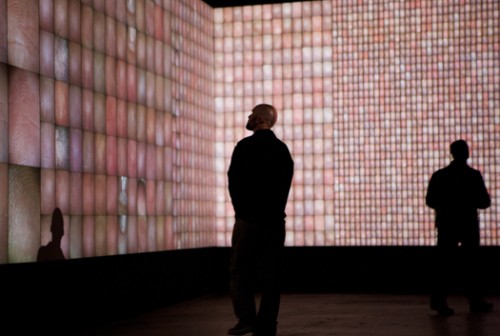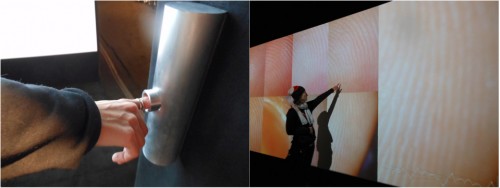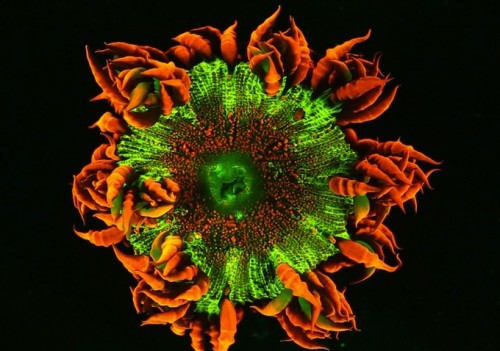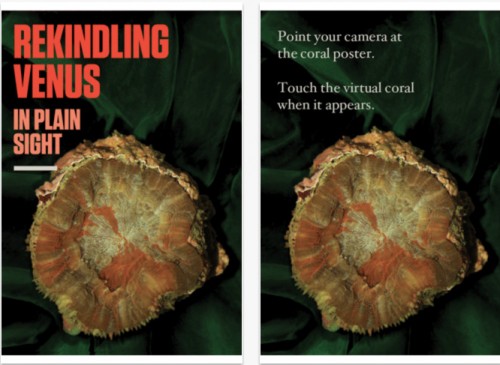
Rafael Lozano-Hemmer. “Pulse Index,” 2010; “Time Lapse,” Site Santa Fe, New Mexico, 2012. Photo by Kate Russel.
What we see today is an art which seeks a more immediate contact with people than the museum makes possible… we are witnessing, as I see it, a triple transformation—in the making of art, in the institutions of art, in the audience of art. —Arthur Danto, 1997
In this third post of my 2013 New Frontier [see the first and second posts] series I revisit Nicolas Bourriaud’s theory of relational aesthetics based on contemporary artworks that focus on human relationality. In Bourriaud’s system, art is meant to model possible universes of authentic human sociability. Relational aesthetics takes the dynamic social environment as its subject and envisions the gallery as a site of human exchange, renewed sociability, and social interaction. Bourriaud writes, “Herein lies the most burning issue to do with art today: is it still possible to generate relationships with the world, in a practical field art-history traditionally earmarked for their ‘representation’?”

Rafael Lozano-Hemmer. “Pulse Index” at New Frontier, (2013). Photos by Nettrice Gaskins.
New Frontier engaged this idea by presenting Rafael Lozano-Hemmer’s Pulse Index, one of a few interactive and social installations on display for the Sundance festival. This piece records participants’ fingerprints at the same time as it detects their heart rates. To participate, I put my finger into a custom-made sensor equipped with a powerful digital microscope and a heart rate device. A fingerprint immediately appeared on the largest cell of the display that pulsated to my heart beat. As more people contributed their fingerprints my recording traveled upwards and across until it disappeared altogether—creating along the way a Fibonacci pattern. Fibonacci patterns can be found everywhere in nature, from the clusters of florets in a sunflower to the bracts of a pinecone. These patterns are applicable to the growth of every living thing, including fingerprints.
In relational aesthetics-based artwork, viewers experience a constructed social environment that becomes the art. The task of the artist is to create (augmented, interactive) space as a conduit for this social experience. To that end, Lozano-Hemmer created an space that scans individual audience member’s heart rates and fingerprints, making these biological representations the actual art. Another artist, Lynette Wallworth, offered a different kind of social environment in an adjoining room.

Lynette Wallworth. “Coral Rekindling Venus,” 2013. Image courtesy of New Frontier and the artist.
Wallworth’s Coral Rekindling Venus screened in a small portable dome and will be a part of Sundance USA in various locations across the country. Coral RKV film screenings were booked solid, but I managed to get a ticket to experience it in the specially constructed full-dome planetarium at New Frontier. Inside the dome there were only cushions and beanbags on the floor. We had to lie down to view the film from below, which simulated the effect of being immersed in a planetarium or, as I imagined, in a submarine entering the ocean and descending downward into the unseen depths of the world’s coral reefs.
Viewing the introduction to Coral RKV online doesn’t do this work justice. It was an amazing experience laying there under the dome. Coral RKV has been compared to Koyaanisqatsi (1982), a film that consists of slow motion and time-lapse footage of natural and urban landscapes in the U.S. Like Koyaanisqatsi, Coral Rekindling Venus is a visual tone poem in that the tone is set by the juxtaposition of images and music. On the walls surrounding the dome screen were six framed images of coral. Each oceanic artifact was presented on dark, draped fabric and each image was created to trigger 3D animations as Augmented Reality (AR) overlays. Coral RKV is an artistic Augmented Reality application that works with the Coral Rekindling Venus posters to provide a portal to sea surface temperatures on the worlds’ coral reefs. It can be used to scan the images from any Coral RKV poster and watch the 3D reef environment come alive.

Mark Billinghurst. “Coral RKV app,” 2013. Images courtesy of Mark Billinghurst.
As with Yung Jake’s Augmented Real, the coral artifact (object) can be displayed on a poster to trigger the 3D Augmented Reality animation. These images are portable, meaning you can visit the website, print the posters, and experience the AR wherever you happen to be, without the planetarium (unfortunately). Just download the Coral RKV app to your smartphone or iPad, launch the app, and point your inboard camera at the poster. Tapping your screen activates the animation. Pressing the green button on the screen pings the Coral Reef Watch data feed of the National Oceanic and Atmospheric Administration. Overlaid against the continuously animated 3D backdrop, it delivers real-time information on the state of the coral reefs depicted in the film.
What I hoped is that you would feel the connection to the reefs through the work, and maintain the connection to the reefs through the augmented reality app. It’s the maintaining of the relationship that becomes important, says Wallworth.
As examples of relational aesthetics, Pulse Index and Coral Rekindling Venus each provide different types of social environments: the interactive gallery space, the augmented gallery space, and small portable dome planetarium. The experience of contributing personal fingerprints and pulses—or becoming immersed in a underwater world—becomes the art on display, under the direction of the artist who acts as a sort of experience conductor. It was great to be invited to go along for the ride.




Pingback: Art 2.1 | New Frontier at Sundance 2013: The Compilation « SL Art HUD Blog Thingie:
Pingback: 2013: A Year in Review | Renegade Futurism